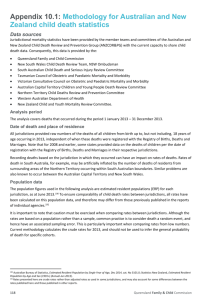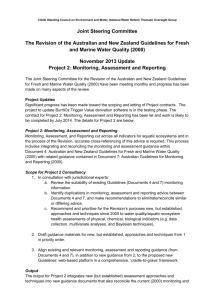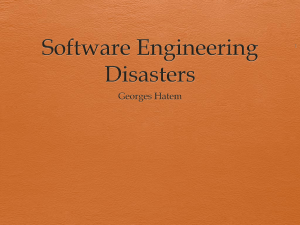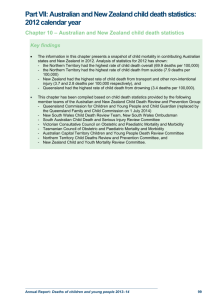Appendix 10.1 - Queensland Family and Child Commission
advertisement
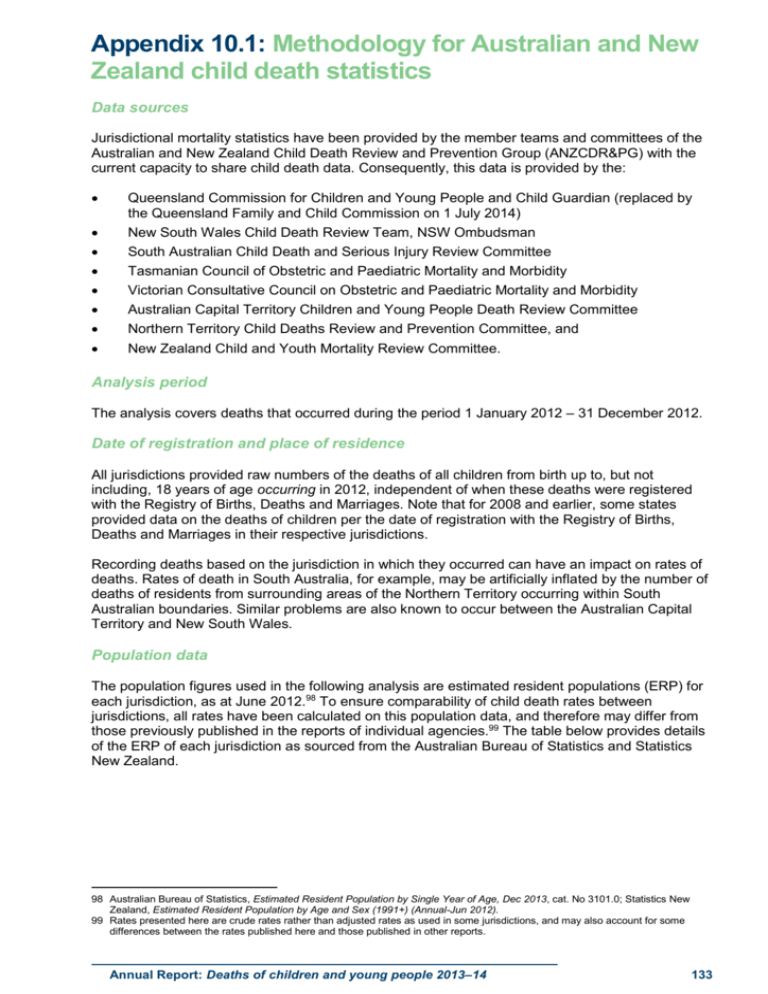
Appendix 10.1: Methodology for Australian and New Zealand child death statistics Data sources Jurisdictional mortality statistics have been provided by the member teams and committees of the Australian and New Zealand Child Death Review and Prevention Group (ANZCDR&PG) with the current capacity to share child death data. Consequently, this data is provided by the: Queensland Commission for Children and Young People and Child Guardian (replaced by the Queensland Family and Child Commission on 1 July 2014) New South Wales Child Death Review Team, NSW Ombudsman South Australian Child Death and Serious Injury Review Committee Tasmanian Council of Obstetric and Paediatric Mortality and Morbidity Victorian Consultative Council on Obstetric and Paediatric Mortality and Morbidity Australian Capital Territory Children and Young People Death Review Committee Northern Territory Child Deaths Review and Prevention Committee, and New Zealand Child and Youth Mortality Review Committee. Analysis period The analysis covers deaths that occurred during the period 1 January 2012 – 31 December 2012. Date of registration and place of residence All jurisdictions provided raw numbers of the deaths of all children from birth up to, but not including, 18 years of age occurring in 2012, independent of when these deaths were registered with the Registry of Births, Deaths and Marriages. Note that for 2008 and earlier, some states provided data on the deaths of children per the date of registration with the Registry of Births, Deaths and Marriages in their respective jurisdictions. Recording deaths based on the jurisdiction in which they occurred can have an impact on rates of deaths. Rates of death in South Australia, for example, may be artificially inflated by the number of deaths of residents from surrounding areas of the Northern Territory occurring within South Australian boundaries. Similar problems are also known to occur between the Australian Capital Territory and New South Wales. Population data The population figures used in the following analysis are estimated resident populations (ERP) for each jurisdiction, as at June 2012.98 To ensure comparability of child death rates between jurisdictions, all rates have been calculated on this population data, and therefore may differ from those previously published in the reports of individual agencies.99 The table below provides details of the ERP of each jurisdiction as sourced from the Australian Bureau of Statistics and Statistics New Zealand. 98 Australian Bureau of Statistics, Estimated Resident Population by Single Year of Age, Dec 2013, cat. No 3101.0; Statistics New Zealand, Estimated Resident Population by Age and Sex (1991+) (Annual-Jun 2012). 99 Rates presented here are crude rates rather than adjusted rates as used in some jurisdictions, and may also account for some differences between the rates published here and those published in other reports. Annual Report: Deaths of children and young people 2013–14 133 Estimated resident population by age category and jurisdiction, June 2012 Age category Jurisdiction Under 1 year 1–4 years 5–9 years 10–14 years 15–17 years Total (0–17 years) Queensland New South Wales 63,236 98,191 248,287 381,847 301,108 455,948 296,587 445,081 182,002 274,618 1,091,220 1,655,685 South Australia 20,199 78,880 96,396 97,808 62,140 355,423 Victoria 74,696 285,584 340,546 330,483 207,987 1,239,296 Tasmania 6,309 25,391 31,081 32,522 20,558 115,861 Northern Territory Australian Capital Territory New Zealand 3,968 14,813 17,670 16,778 9,736 62,965 5,728 19,917 22,507 21,139 13,279 82,120 61,770 255,370 291,710 301,420 186,670 1,096,940 Data source: Australian Bureau of Statistics; Statistics New Zealand Estimates for the Australian Aboriginal and Torres Strait Islander child population are based on experimental estimates for 2008 to 2012.100 Estimates for the New Zealand Māori population are based on estimated resident populations and were available by single year of age.101 The below table provides details of estimates of the Indigenous child population in each jurisdiction as used in the calculation of death rates in the following analysis. Estimated Indigenous population aged 0–17 years by jurisdiction, June 2012 Jurisdiction Estimated Indigenous population Queensland New South Wales 84,707 90,840 South Australia 15,669 Victoria 20,343 Tasmania 10,418 Northern Territory Australian Capital Territory New Zealand 26,677 2,410 273,770 Data source: Australian Bureau of Statistics; Statistics New Zealand 100 101 134 Australian Bureau of Statistics, Estimates and projections, Aboriginal and Torres Strait Islander Australians, 2001 to 2026, cat. no. 3238.0. Statistics New Zealand, Total Māori estimated resident population, by single-year of age, five-year age group, broad age group, and median age, 1991–2013. Queensland Family and Child Commission Data extraction and methodological differences To assist with comparative research regarding the prevention of child deaths, the ANZCDR&PG has agreed to report under a number of research categories based on the circumstances of death. These research categories capture diseases and morbid conditions and the major external causes of death: transport, drowning, suicide, other non-intentional injury, and fatal assault and neglect. However, it is important to recognise that the deaths counted under each category are as per that particular agency’s classification. In many cases, agencies have multiple sources of information available concerning children (including health, welfare and education records) and are not limited to the causes of death recorded in post-mortem reports or death certificates. Accordingly, a team or committee’s classification for a particular death may vary from the World Health Organisation’s International Classification of Diseases (version 10-AM) classifications. Notable differences include: the Victorian Consultative Council on Obstetric and Paediatric Mortality and Morbidity (CCOPMM) apply coding of neonatal (0–27 days) deaths according to PSANZ-PDC102 and PSANZ-NDC103 rather than ICD-10. However Victorian data provided by the council for this report have been recoded into the ICD-10 Victorian figures exclude neonatal deaths as a result of terminations of pregnancy (for congenital anomaly or other maternal reason) and those born less than 20 weeks’ gestation, or, if the gestation is unknown, less than 400g birth weight, and the methodology for classification of external cause deaths by the South Australian Child Death and Serious Injury Review Committee is available in the Committee’s Annual report at www.cdsirc.sa.gov.au, including a revision of the classification of fatal assault. A number of additional issues affecting data for particular jurisdictions should also be noted: 102 103 The Victorian CCOPMM note that the data provided are provisional only. Final data will be available in the yet to be published Annual Report for the Year 2012. This will be available from www.health.vic.gov.au/ccopmm/index.htm. The Victorian CCOPMM does not specify raw figures where these are less than 10. These are represented by the figure <10 throughout the analysis. The South Australian Child Death and Serious Injury Review Committee does not specify raw figures where these are less than four. These are represented by the figure <4 throughout the analysis. The New Zealand Child and Youth Mortality Committee notes that: data is from the NZ Mortality Review Database, which collects and stores data for the Child and Youth; and Perinatal and Maternal Mortality Review Committees data consists of deaths occurring in the age range of 20 weeks gestation (or birth weight 400g) up to but not including the 18th birthday only deaths of New Zealand residents are included in these analyses (overseas deaths are excluded) raw numbers are not specified when they are less than three infant mortality is usually calculated using live births in New Zealand, so presented figures will differ from official New Zealand statistics, and deaths are recorded as a suicide only when they have been found to be so after the process of Coronial review. Perinatal Society of Australia and New Zealand – Perinatal Death Classification. Perinatal Society of Australia and New Zealand – Neonatal Death Classification. Annual Report: Deaths of children and young people 2013–14 135
